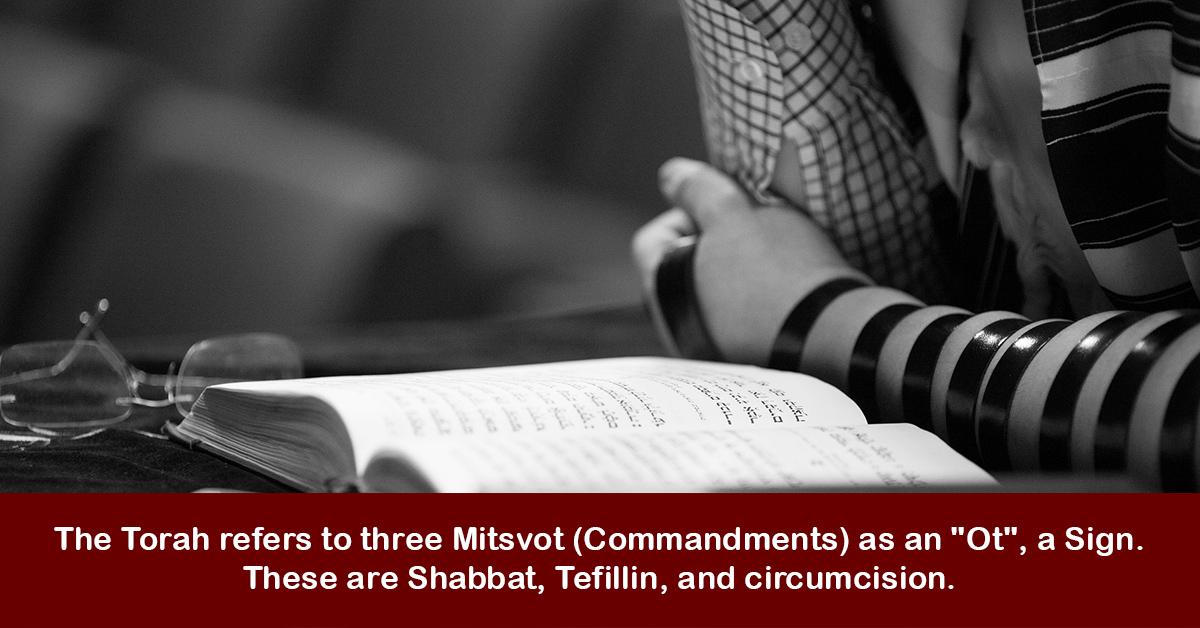
The Torah refers to three Mitsvot (Commandments) as an "Ot", a Sign. These are Shabbat, Tefillin, and circumcision.
The commentary, Tikun Tephillah, explains that we don’t find the term, “Tefillin” used anywhere in the Bible. The earliest mention of this term is in the Mechiltah and in the Tanchumah, written about 100 years before the destruction of the second Temple. The word’s source is תפל, meaning tightly attached, as we see in Ezekiel, where it says, "והנם טחים אותו תפל", i.e. they are plastering something snugly. Another example is in the Talmud, where it says that a woman prefers one portion (of wealth), together with a close relationship with her husband, rather than nine portions by herself. This name, “Tefillin", explains why we wear Tefillin, (or “Totafot”, Ornaments, as the Torah calls them). We wear a Sign to show us that we are set apart from other nations and that we cleave to G-d.
Rabbeynu Bachya also notes that the Mitzvah of Tefillin demonstrates that we cleave to G-d, and that we are commanded to make Tefillin into a reminder and something to remember, so that this will be inscribed into our hearts. We are also required to make this reminder on two parts of our body, our arm and head. This makes our actions and thoughts subject to Him and makes us cleave to Him.
This name, “Tefillin” was introduced during the Babylonian (present) Exile so that people would be constantly reminded of their obligations and subjugation to their Father in Heaven. The idea was to keep them away from ritual uncleanliness and assimilation.
The Torah gives us another reason, as it tells us, “It shall be a sign on your arm, and a reminder between your eyes, so that the Lord’s Torah will be in your mouth.” We wear a sign on our hand and a reminder between our eyes, so that Torah should be what we talk about.
The Tefillin on our arm is called Tefillin Shel Yad, and the Tefillin on our head is called Tefillin Shel Rosh.
Why do we lay the Tefillin Shel Yad first, and only lay the Tefillin Shel Rosh afterwards? Why do we have to be particular to lay our Tefillin on our left hand (unless we are left-handed)? After all, our left hand is generally weaker. Wouldn’t it be better to lay our Tefillin on the stronger arm?
If we look at the two verses discussing Tefillin, they say; -
These verses mean that; -
The Torah has mentioned a Sign, which refers to Tefillin Shel Yad, before it mentions a reminder or an ornament, which both refer to Tefillin Shel Rosh. Tefillin Shel Yad have been given precedence over Tefillin Shel Rosh in both cases. Therefore, we lay our Tefillin Shel Yad first, before our Tefillin Shel Rosh.
If we look at Tefillin Shel Yad, the Talmud asks which hand we should lay our Tefillin Shel Yad on. Rav Ashi deduces from the second verse, והיה לאות על ידכה, i.e. “And it shall be a sign on your arm”, where a letter ה has been added to the word ידכה, that this implies weakness, and Rashi explains that this implies femininity, as a woman is not as strong as a man. So we lay Tefillin on our weaker arm, the left arm if we are right-handed, and the right arm if we are left-handed.
The Kli Yakar gives additional reasons for laying Tefillin on our weaker arm. Everybody knows that intelligence and physical wellbeing are like having two or more wives. When one becomes dominant, the other gets a lower stature, and the reverse is also true. Youth has strength but doesn’t necessarily have common sense. An older man has common sense but isn’t very strong. When somebody suffers physically, he becomes more intelligent. In fact, that is why the Jews had to suffer in Egypt, so that they would become more intelligent as a result of their suffering.
The same reasoning applies with our hands. Our left hand is weaker and not dominant, but is next to our hearts, (one of) the base(s) of our intelligence. Not only that, but the intelligence in our hearts weakens the left hand near it, as a hand deals with material matters, as opposed to the heart next to it. The two oppose each other. The right hand is not affected in this way, as it is next to the liver, the source of our appetite. The liver does not oppose the right hand next to it. When the Torah tells us, that it should be a sign on your arm, it is virtually telling us that we should have a sign over our hearts. The whole reason that we wear Tefillin is to make our intelligence aware, to be a reminder. We do this where our intelligence resides, in our hearts and head.
Not only that, but our eyes and heart tempt us to sin. Therefore, we need to be reminded in these two places that G-d exists, and what He can do. That can help prevent us from going astray.
So we can see what the order with Tefillin should be. We have also seen which hand we should lay our Tefillin on, and why.
The Besamim Rosh discusses the effect of our wearing Tefillin, both on us, and on the worlds around and above us. We should also discuss what happens when we pray without Tefillin.
What happens when we pray without Tefillin
The Talmud tells us that whoever reads Kriat Shema without Tefillin is considered as having testified falsely (about himself). Since he is reading the verse, “Bind them as a Sign on your arm and they will be Ornaments between your eyes” and is not doing these things when he has to, then he is effectively testifying falsely. He is not fulfilling what he himself is saying. Even though he is doing a Mitzvah by reading Kriat Shema and praying, he is still testifying falsely. The Levush points out that some people understand that he is actually testifying falsely against G-d rather than himself. This is because he is reading that “It will be that if you will hearken” and also that “I will give dew in your Land”, which infers that if we don’t do what G-d tells us, then we won’t get dew, etcetera. Somebody reading Kriat Shema without Tefillin, though, is not doing what G-d tells us, and still expects dew to fall, etcetera. He still expects a nice living. He is implying that we don’t need to listen to what G-d tells us, and that we will still get our reward.
What happens when we pray with Tefillin
The Rosh and Tur quote Ravah as saying that whoever lays Tefillin, wraps himself in Tzitzit, reads Kriat Shema and prays, is promised the World to Come. Abaye adds that he guarantees that Hell will not affect him, whereas Rav Papah guarantees that all this person’s sins will be forgiven. The Zohar writes that when we go out of our house with Tzitzit and Tefillin, then four angels join and come out with us. They come to the synagogue with us, and cry out, “Let’s us call the King’s image.” We look like our King when we have our Talit and Tefillin on.
The Shulchan Oruch tells us that when we lay Tefillin, we should have in mind that G-d has commanded us to lay these four Torah quotations in the Tefillin on ourselves, and that these Torah quotations sanctify His unique Name, and also discuss our coming out of Egypt. We wear one Tefillin on our arm and another on our head, so that we will remember the wonderful miracles that He has wrought for us, and that they teach us how unique He is. We also have to keep in mind that He has the power and authority, both in the worlds above and in the worlds below, to do as He wishes.
We must also subjugate our soul, which resides both in our heart and mind, to G-d. We must realize at the same time, though, that these two places, our hearts and minds, are also the main sources leading us to sin. Now we have the chance to think about G-d in those parts of our body, and realize which is more important, i.e. G-d and his Mitzvot.



